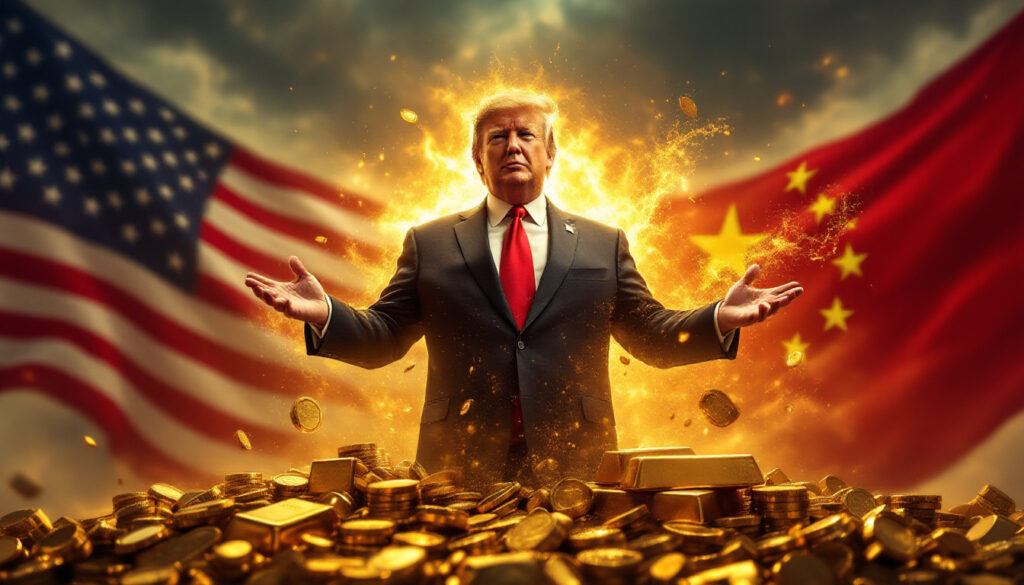What Are the Latest Developments in US-China Trade Tensions?
The global markets are once again navigating choppy waters as trade tensions between the United States and China resurface. President Trump has recently ordered a new comprehensive tariff investigation targeting critical mineral shortages from China, signaling a potential escalation in the ongoing economic rivalry between the world's two largest economies.
The investigation specifically focuses on minerals deemed essential for U.S. national security and economic prosperity, including rare earth elements, lithium, cobalt, and graphite. These resources are fundamental components in everything from military equipment to renewable energy technologies and consumer electronics, making them strategically vital to American industrial interests.
According to market analysts, this move represents a targeted approach to reducing U.S. dependency on China's critical mineral exports, which currently dominate global production and processing. China controls approximately 60% of rare earth mining and nearly 90% of processing capacity worldwide, creating a vulnerability that U.S. policymakers have increasingly sought to address.
The timeline for this investigation remains fluid, with preliminary findings expected within 60-90 days, followed by potential tariff implementation by year-end. This uncertainty has already triggered market volatility, particularly in commodity and precious metals sectors.
Historical Context of US-China Trade Relations
Current tensions don't exist in isolation but rather represent the latest chapter in a complex economic relationship. The 2018-2020 trade disputes saw the U.S. impose tariffs on approximately $360 billion worth of Chinese goods, with China retaliating on roughly $110 billion of U.S. products.
Those earlier conflicts primarily targeted manufacturing, agriculture, and technology sectors. The current focus on critical minerals represents a strategic pivot toward resource security and supply chain resilience. This shift comes as global powers increasingly recognize the importance of mineral resources in advanced technologies and green energy transitions.
Previous tariff implementations triggered immediate market reactions, with China's currency depreciation, stock market volatility, and a notable flight to safe-haven assets. Economic data showed both countries experienced negative impacts – U.S. manufacturing contracted while Chinese exports declined significantly during peak tension periods.
Market veterans note important distinctions in this latest dispute. Unlike previous broad-based tariffs, this mineral-focused investigation targets a specific vulnerability in America's industrial supply chain, potentially indicating a more surgical approach to economic competition with China.
How Has Gold Responded to Renewed Trade Tensions?
Record-Breaking Price Movements
Gold has responded dramatically to the renewed trade tensions, with spot prices surging 2.7% to reach an unprecedented $3,313 per ounce. This milestone represents not merely an incremental gain but a decisive breakthrough above the psychologically significant $3,300 threshold. Simultaneously, U.S. gold futures have climbed to approximately $3,327, reflecting robust forward expectations among traders.
The precious metal's upward trajectory demonstrates remarkable momentum, having broken through multiple resistance levels that technical analysts had previously identified around $3,100 and $3,250. Trading volumes on major exchanges have spiked nearly 40% above their 30-day averages, indicating heightened market interest and participation.
What makes this rally particularly noteworthy is its acceleration during typically subdued trading sessions. The single-day gain of 2.7% represents one of the largest daily moves in percentage terms since the post-pandemic volatility of 2020, suggesting extraordinary buying pressure and market conviction.
Gold's 2025 Performance Metrics
Gold's year-to-date performance has been nothing short of remarkable, posting a 27% increase that outpaces virtually all major asset classes. This performance stands in stark contrast to broader market indices and even other commodities, many of which have struggled amid economic uncertainty.
Monthly progression data reveals an accelerating trend, with gains of 3.2% in January, 4.5% in February, 7.3% in March, and now approaching double-digits in April alone. This sequential strengthening indicates building momentum rather than speculative spikes.
Compared to other investment vehicles, gold has significantly outperformed global equities, which have delivered mixed results across different markets. The S&P 500's modest 5% YTD gain and emerging market indices' generally flat performance highlight gold's superior returns during this period of heightened uncertainty.
Perhaps most telling is gold's outperformance against other traditional inflation hedges and safe-haven assets. Treasury Inflation-Protected Securities (TIPS) have returned just 2-3%, while even Bitcoin—often touted as "digital gold"—has experienced greater volatility despite comparable returns.
Why Is Gold Rallying During Trade Tensions?
Safe Haven Demand Factors
The pronounced shift toward gold during periods of geopolitical uncertainty follows historical patterns but has intensified in the current environment. Institutional investors have increased their gold allocations by approximately 15% since the announcement of the tariff probe, according to preliminary trading data.
This flight to safety reflects a fundamental market psychology that has remained consistent through centuries of financial history. During periods of uncertainty, investors prioritize capital preservation over yield, and gold's 5,000-year track record as a store of value becomes particularly attractive.
Historical correlation analysis demonstrates that gold typically gains between 4-7% during the first month following major trade tension announcements. The current 2.7% single-day gain suggests this pattern is repeating, potentially with greater magnitude given the additional macroeconomic factors at play.
Portfolio managers increasingly report implementing the 60-30-10 allocation strategy (60% stocks, 30% bonds, 10% gold and alternatives) as a baseline, with many now shifting toward a higher precious metals weighting of 15-20% during periods of heightened geopolitical risk.
Dollar Weakness Contribution
Gold's inverse relationship with the U.S. dollar provides a secondary catalyst for its recent strength. The Dollar Index (DXY) has declined approximately 3.5% since mid-March, creating a favorable environment for dollar-denominated commodities like gold.
This currency dynamic amplifies gold's appeal for international investors, particularly those in emerging markets seeking to preserve purchasing power against dollar fluctuations. Chinese and Indian retail investors, who collectively represent nearly 50% of global gold jewelry demand, have increased their gold purchases as their domestic currencies have strengthened against the dollar.
Currency market analysts note that expectations of Federal Reserve interest rate policies have been a dominant factor in dollar weakness. With markets pricing in potential rate cuts later this year, the opportunity cost of holding non-yielding assets like gold diminishes, enhancing their relative attractiveness.
Global Recession Fears
Perhaps the most powerful driver behind gold's rally is growing concern about global economic deceleration. Leading indicators including inverted yield curves, declining PMI manufacturing data, and downward GDP forecast revisions have collectively heightened recession probabilities.
Gold has historically performed exceptionally well during recessionary periods, delivering average returns of 45% during the last four U.S. recessions. This outperformance during economic contractions makes it particularly attractive as a portfolio component when recession risks increase.
The trade tensions themselves exacerbate these fears, with economists estimating that a full-scale trade war could reduce global GDP by 0.5-0.7 percentage points. Combined with already slowing economic indicators, this creates a potent catalyst for gold appreciation.
What Other Factors Are Driving Gold's Price Movement?
Central Bank Policies and Interest Rate Environment
Beyond trade tensions, central bank policies continue to significantly influence gold market trends. Central banks globally have purchased approximately 800 tons of gold in the past 12 months, representing the most aggressive acquisition pace in over half a century.
China alone has added roughly 15 tons monthly to its reserves since January, while other nations including Poland, Turkey, and India have similarly expanded their gold holdings. This institutional buying provides a stable demand floor underpinning the market.
The interest rate environment remains particularly favorable for gold. Despite earlier expectations of persistently higher rates, markets have now priced in at least two Fed rate cuts for 2025. Lower rates reduce the opportunity cost of holding non-yielding assets like gold, typically correlating with higher precious metal prices.
The yield curve inversion, with 10-year Treasury yields falling below 2-year yields, has historically been a reliable recession predictor. This signal further enhances gold's appeal as investors position defensively.
Supply and Demand Fundamentals
On the supply side, global gold production has plateaued at approximately 3,500 tons annually, with declining ore grades and increasing extraction costs constraining major producers' output. South African output, once the global leader, continues its multi-decade decline due to aging mines and electricity supply challenges from state utility Eskom.
Meanwhile, consumer demand fundamentals remain robust, particularly in key Asian markets. Chinese retail gold demand increased 12% in Q1 2025 compared to the previous year, while Indian wedding season purchases have maintained their traditional strength despite higher prices.
Industrial applications, though representing a smaller percentage of overall demand, are also expanding as technology manufacturers incorporate gold components in advanced electronics. The semiconductor industry alone utilized nearly 70 tons of gold in 2024, with growth projections suggesting this demand segment will expand by 3-5% annually through 2030.
How Are Other Precious Metals Performing Amid Trade Tensions?
Silver, Platinum, and Palladium Market Responses
While gold has captured headlines with its record-breaking performance, other precious metals show divergent trends that provide valuable insights into the broader economic impact of trade tensions.
Silver has posted a respectable 15% YTD gain, benefiting from both its monetary characteristics and industrial applications. Trading at a gold-to-silver ratio of approximately 85:1, many analysts consider silver undervalued relative to historical averages closer to 60:1, suggesting potential outperformance if industrial demand remains resilient.
Platinum, heavily used in automotive catalytic converters, has experienced more modest appreciation at 7% YTD. Its price movements reflect both safe-haven buying and concerns about vehicle production amid economic uncertainty.
Palladium presents the most complicated picture, having declined approximately 5% YTD despite its critical applications in emission control systems. This underperformance largely stems from concerns about automotive production slowdowns if trade tensions escalate, highlighting the complex interplay between monetary and industrial demand factors.
Mining Sector Implications
Major gold producers' stocks have generally outperformed the physical metal, with the NYSE Arca Gold Miners Index gaining approximately 32% YTD compared to gold's 27% increase. This leverage effect reflects miners' operational leverage to gold prices, with each dollar increase in gold prices flowing disproportionately to miners' bottom lines once production costs are covered.
Production costs remain a critical consideration in the current environment. Industry-average all-in sustaining costs (AISC) hover around $1,300 per ounce, providing substantial margins at current gold prices above $3,300. This profitability surge has enabled miners to reduce debt, increase dividends, and accelerate exploration activities.
Exploration and development projects have seen renewed financing interest, with junior mining stocks guide companies raising nearly $3.5 billion in the first quarter of 2025 alone – more than double the prior year's pace. This capital influx suggests the industry anticipates sustained higher gold prices, potentially expanding future supply if prices remain elevated.
What Are Expert Predictions for Gold Prices?
Short-term Price Forecasts
Technical analysts identify $3,500 as the next significant resistance level for gold, with potential consolidation expected between $3,250-$3,400 in the near term. Chart patterns suggest the possibility of a brief pullback to test support around $3,200 before resuming the upward trend.
Fibonacci retracement analysis indicates key support levels at $3,180 (23.6% retracement) and $3,050 (38.2% retracement) should any meaningful correction materialize. However, momentum indicators remain strongly positive, with RSI readings suggesting gold is approaching overbought territory but not yet at extreme levels.
Major financial institutions have rapidly revised their price targets upward. Goldman Sachs recently projected a $3,600 year-end target, while Bank of America suggests $3,800 is possible if trade tensions escalate further and recession indicators strengthen.
Long-term Outlook Considerations
Beyond immediate trade tensions, structural factors supporting sustained gold strength include ongoing central bank diversification away from U.S. dollar reserves, persistent global debt levels exceeding 350% of GDP, and growing recognition of gold as a strategic asset in multipolar geopolitical environments.
Analysts increasingly discuss potential price ceilings in the $4,000-$5,000 range within the current economic cycle, particularly if inflation proves more persistent than expected or if geopolitical flashpoints intensify beyond current projections.
The role of gold in future investment portfolios appears to be expanding beyond traditional allocations. Pension funds that historically maintained minimal gold exposure (0-2%) have begun implementing target allocations of 5-10%, representing a significant structural shift in institutional thinking about the metal's strategic importance.
How Can Investors Respond to the Current Gold Market?
Investment Strategies During Trade Tensions
Financial advisors increasingly recommend a tiered approach to gold allocation during periods of heightened uncertainty. Core positions of 5-10% provide baseline portfolio protection, while tactical allocations of an additional 5-15% can be implemented during periods of elevated risk.
Risk management approaches have evolved beyond simple buy-and-hold strategies. Options strategies such as protective puts on gold positions can shield against potential corrections while maintaining upside exposure. Alternatively, collar strategies (buying puts while selling calls) can generate income while establishing price ranges for more risk-averse investors.
Timing considerations remain challenging given gold's already substantial YTD gains. Dollar-cost averaging into positions over 3-6 months rather than lump-sum investments may provide better risk-adjusted outcomes, particularly for investors concerned about entry points after such significant price appreciation.
Gold Investment Vehicles Comparison
Physical gold ownership, while providing direct asset control, involves storage costs averaging 0.5-1.5% annually, insurance considerations, and potential liquidity constraints during crisis periods. These factors make physical gold most appropriate for long-term strategic holdings rather than tactical allocations.
Gold ETFs offer superior liquidity and minimal tracking error at expense ratios typically ranging from 0.25-0.50%. The largest funds (SPDR Gold Shares, iShares Gold Trust) trade over $1 billion daily, ensuring tight bid-ask spreads even during market stress. These characteristics make ETFs suitable for both strategic and tactical allocations.
Mining stocks provide operational leverage to gold prices but introduce company-specific risks including management execution, geopolitical exposure, and production disruptions. Historically, miners exhibit higher volatility (beta approximately 1.5-2.0 to gold prices) but have outperformed during bull markets. This risk-reward profile makes them appropriate for investors comfortable with higher volatility seeking to maximize returns during gold price surges.
FAQs About Gold and Trade Tensions
How do trade tariffs typically affect gold prices?
Historical data demonstrates that gold typically appreciates 5-15% during the six months following major tariff implementations. Following the 2018 tariff announcements, gold gained approximately 8% in the subsequent quarter while global equities declined, highlighting its effectiveness as a portfolio hedge during trade disputes.
The transmission mechanism between trade policy and precious metals markets operates primarily through risk sentiment, currency effects, and growth expectations. Tariffs typically reduce economic growth forecasts, increase inflation expectations, and trigger safe-haven flows – all supportive factors for gold prices.
Market adjustments following tariff announcements typically evolve through three phases: initial volatility (1-2 weeks), price discovery and reassessment (2-8 weeks), and trend establishment (2-6 months). Current gold market behavior suggests we remain in the initial volatility phase following the critical minerals investigation announcement.
What are critical minerals and why do they matter to US-China relations?
Critical minerals encompass approximately 50 resources deemed essential for national security, economic prosperity, and technological leadership. The U.S. Department of the Interior formally designates these materials based on their importance to vital industries and vulnerability to supply disruptions.
China's dominance in this sector is extraordinary – controlling approximately 80% of rare earth processing capacity globally despite possessing only about 35% of reserves. This asymmetry creates strategic leverage that extends beyond simple economic competition into national security considerations.
The strategic importance of these resources has grown exponentially with technological advancement. A single F-35 fighter jet contains nearly 920 pounds of rare earth materials, while electric vehicle production requires substantial quantities of lithium, cobalt, and nickel. Renewable energy infrastructure similarly depends on these resources, making them central to both climate and security objectives.
How does gold compare to other safe haven assets during trade tensions?
Comparative analysis shows gold has historically outperformed other traditional safe havens during trade disputes. While U.S. Treasury bonds typically appreciate 2-4% during acute trade tensions, gold has averaged 5-15% gains during comparable periods.
Currency safe havens like the Swiss franc and Japanese yen show mixed results, often appreciating against most currencies but maintaining complex relationships with gold depending on dollar movements. Gold's advantage lies in its lack of counterparty risk and universally recognized value independent of any single government's policies.
Diversification benefits across different safe haven assets remain significant, with correlation coefficients between gold and Treasuries typically falling between 0.1-0.3 during normal markets but often turning negative during acute crises. This pattern reinforces the case for maintaining allocations across multiple safe haven categories rather than concentrating in any single asset class.
What indicators should investors watch to anticipate gold's next move?
Key economic indicators with strong predictive relationships to gol
Ready to Stay Ahead of Critical Mineral Markets?
Stay informed about the latest developments in US-China trade tensions and their impact on gold prices by subscribing to Discovery Alert's proprietary Discovery IQ model, which provides real-time alerts on significant mineral discoveries and market-moving events. Visit our discoveries page to understand how major mineral discoveries can lead to exceptional market returns and begin your 30-day free trial today.




